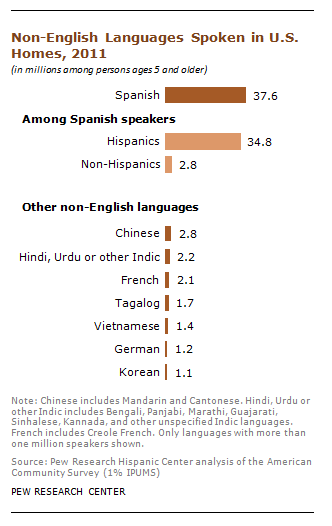
A record 37.6 million persons ages 5 years and older speak Spanish at home, according to an analysis of the 2011 American Community Survey by the Pew Research Center.
Spanish is, by far, the most spoken non-English language in the U.S. The next most spoken non-English languages are Chinese (with 2.8 million speakers), Hindi, Urdu or other Indic languages (2.2 million), French or French Creole (2.1 million), and Tagalog (1.7 million).
The number of Spanish speakers in the U.S. has grown rapidly in recent decades, reflecting the arrival of new immigrants from Latin America and growth in the nation’s Hispanic population. Today 34.8 million Hispanics ages 5 and older speak Spanish at home.
However, not all Spanish speakers are Hispanic. According to our analysis, some 2.8 million non-Hispanics speak Spanish at home today. That places Spanish at the top of the list of non-English languages spoken by non-Hispanics along with Chinese and ahead of all other languages.
(The U.S. Census Bureau measure of non-English language use captures how many people say a language other than English is spoken in the home but does not capture how well or how often the language is spoken).
Who are the 2.8 million non-Hispanics who speak Spanish at home? Some 59% trace their ancestry to non-Spanish European countries such as Germany, Ireland, England and Italy. An additional 12% say they are of African American descent. Nonetheless, about one-in-five (18%) non-Hispanic Spanish speakers trace their heritage to a Spanish-speaking country. By comparison, among the non-Hispanic U.S. population ages 5 and older, about two-thirds (64%) trace their ancestry to non-Spanish European countries, 13% say their ancestry is African American and 1% trace their heritage to a Spanish-speaking country.
Nine-in-ten (89%) of non-Hispanic Spanish speakers were born in the U.S., a share similar to that for all non-Hispanics ages 5 and older (91%).
The racial composition of non-Hispanic Spanish speakers mirrors that of the U.S. non-Hispanic population. Overall, three-quarters (77%) of non-Hispanics who speak Spanish at home are white, 14% are black, and 9% say they belong to some other racial group. Among the non-Hispanic U.S. population ages five years and older, 76% are white, 14% are black, and 9% are some other race.
Many non-Hispanic Spanish speakers reside in a household where at least one other member is Hispanic. Overall, 26% of non-Hispanic Spanish speakers live in these types of households. By comparison, just 3% of all non-Hispanics ages 5 and older live in such households.
Three-in-ten (28%) non-Hispanics Spanish speakers who are married live with a Hispanic spouse. By comparison, only 2% of non-Hispanics are living with a Hispanic spouse.
When it comes to English proficiency, eight-in-ten (80%) non-Hispanics who speak Spanish at home say they speak English “very well”, 11% say they speak English “well”, and 9% say they speak English “not well” or do not speak English. This compares with 96% of all non-Hispanics 5 years and older who speak English only or speak it “very well”, 2% who speak English “well”, and 2% who speak English “not well” or do not speak English.

